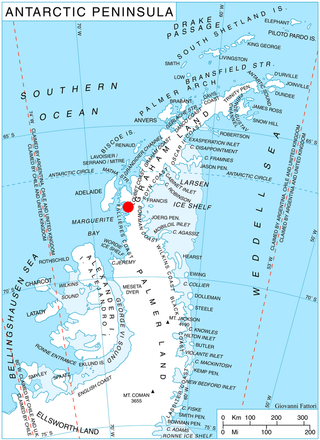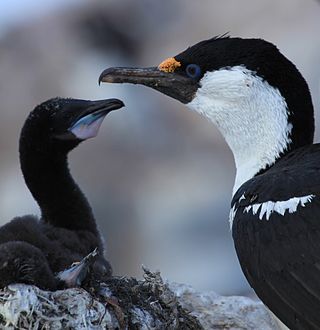Related Research Articles
The Trojan Range is a mountain range rising to 2,760 metres (9,055 ft), extending northward from Mount Francais along the east side of Iliad Glacier, Anvers Island, in the Palmer Archipelago of the British Antarctic Territory. It was surveyed by the Falkland Islands Dependencies Survey (FIDS) in 1955 and named by the UK Antarctic Place-Names Committee (UK-APC) for the Trojans, one of the opposing sides in the Trojan War in Homer's Iliad.
Athene Glacier is a glacier, 10 miles (16 km) long, flowing east and merging with the terminus of Casey Glacier where it discharges into Casey Inlet, on the east coast of the Antarctic Peninsula.

Telefon Bay is a small bay on the north-west coast of Port Foster, Deception Island, in the South Shetland Islands of Antarctica. It is surmounted by Telefon Ridge. The name appears on the chart of the French Antarctic Expedition under Charcot, 1908–10.
Prioress Island is a narrow island lying 0.5 nautical miles (0.9 km) east of Host Island in the Wauwermans Islands, in the Wilhelm Archipelago. Shown on an Argentine government chart of 1954. Named by the United Kingdom Antarctic Place-Names Committee (UK-APC) in 1958 after one of the characters in Geoffrey Chaucer's Canterbury Tales.

Bagshawe Glacier is a glacier which drains the northeast slopes of Mount Theodore and discharges into Lester Cove, Andvord Bay west of Mount Tsotsorkov, on the west coast of Graham Land, Antarctica.
The Bayard Islands are a small group of islands lying 1.6 km (1 mi) northeast of Cape Willems, off the west coast of Graham Land. They were charted by the Belgian Antarctic Expedition under Gerlache, 1897–99, and named by the UK Antarctic Place-Names Committee in 1960 for Hippolyte Bayard, a French civil servant who, in 1839, independently invented a photographic process for obtaining direct positives on paper.
Clowes Glacier is a glacier 2 nautical miles (4 km) wide, which flows east to enter Mason Inlet, on the east coast of Palmer Land. It was discovered and photographed from the air in December 1940 by the United States Antarctic Service. During 1947 it was photographed from the air by the Ronne Antarctic Research Expedition under Finn Ronne, who in conjunction with the Falkland Islands Dependencies Survey (FIDS) charted it from the ground. It was named by FIDS for Archibald J. Clowes, English oceanographer on the staff of the Discovery Committee, 1924–46.
Davies Top is a conspicuous isolated peak 2,360 metres (7,740 ft) high on the east side of Wakefield Highland, near the head of Lurabee Glacier in northern Palmer Land. It was photographed from the air by the Ronne Antarctic Research Expedition on December 22, 1947, and surveyed by the Falkland Islands Dependencies Survey (FIDS) in November 1960. It was named by the UK Antarctic Place-Names Committee after Antony G. Davies of FIDS, who was Medical Officer at Horseshoe Island and Stonington Island, 1960.

Deloncle Bay is a bay, 1.5 nautical miles (3 km) long, indenting the northwest coast of Kyiv Peninsula in Graham Land between Loubat Point and Glandaz Point, and opening on Lemaire Channel opposite Booth Island. It was discovered by the Belgian Antarctic Expedition, 1897–99. Recharted by the French Antarctic Expedition, 1903–05, it was named by Jean-Baptiste Charcot for François Deloncle, a French diplomat.

Suárez Glacier also known as Petzval Glacier is a glacier flowing into the small cove between Skontorp Cove and Sturm Cove on the west coast of Graham Land. It was first mapped by Scottish geologist David Ferguson in 1913–14. The 5th Chilean Antarctic Expedition (1950–51) remapped it and named it for Lieutenant Commander Francisco Suárez V., Operations Officer on the transport ship Angamos.
Stickle Ridge is a ridge rising to about 720 m, west of Saint Martha Cove on James Ross Island. The weathered red lavas of the ridge were examined by British Antarctic Survey (BAS) geologists during the 1985–86 season. Named descriptively by the United Kingdom Antarctic Place-Names Committee (UK-APC) after the spiny nature of the ridge.

Grubb Glacier is a glacier flowing into Lester Cove, Andvord Bay, to the west of Bagshawe Glacier, on the west coast of Graham Land, Antarctica. The glacier appears on an Argentine government chart of 1952. It was named by the UK Antarctic Place-Names Committee in 1960 for Thomas Grubb, an Irish optician who designed and introduced the first aplanatic camera lens, in 1857.

The Pearl Rocks are a group of rocks covering an area 6 km (3.7 mi) by 4 km (2.5 mi) close to the west coast of Tower Island in the Palmer Archipelago of Antarctica. The name was given by Falkland Islands and Dependencies Aerial Survey Expedition (FIDASE) (1955–57) and is descriptive of the numerous snow-covered rocks in the group.
Friar Island is an island lying immediately northeast of Manciple Island in the Wauwermans Islands, in the Wilhelm Archipelago. It was shown on an Argentine government chart of 1952, but not named. It was named by the UK Antarctic Place-Names Committee in 1958 after The Friar, one of the characters in Geoffrey Chaucer's The Canterbury Tales.
Miethe Glacier is a glacier 3 nautical miles (6 km) long, flowing northwest into Gerlache Strait to the south of Mount Banck, on the west coast of Graham Land, Antarctica. The glacier appears on an Argentine government chart of 1952. It was named by the UK Antarctic Place-Names Committee in 1960 for Adolf Miethe, a German chemist who introduced the first panchromatic emulsion for photographic plates in 1903.

Lucchitta Glacier is a glacier about 20 nautical miles (37 km) long flowing south from the Hudson Mountains of Antarctica into Pine Island Bay. It was named by the Advisory Committee on Antarctic Names after geologist Baerbel K. Lucchitta of the United States Geological Survey, Flagstaff, Arizona, a specialist in the use of satellite imagery for geological and glaciological studies from the early 1980s to the early 2000s (decade), and one of the pioneers in the use of imagery for glacier velocity measurements in Antarctica.
The Lorn Rocks are a group of rocks lying 12 nautical miles (22 km) west of the north end of Lahille Island, in the Biscoe Islands of Antarctica. They were mapped by the Falkland Islands Dependencies Survey from photos taken by Hunting Aerosurveys Ltd in 1956–57, and were so named by the UK Antarctic Place-Names Committee because the rocks are small, forlorn and deserted.
Thomas Cove is the cove south of Haigh Point, Danco Coast. It was first surveyed by the Falkland Islands Dependencies Survey (FIDS) in 1956–57. The cove was named in association with Haigh Point, by the United Kingdom Antarctic Place-Names Committee (UK-APC) in 1985. It was named after Joan Ena Thomas, who was the personal assistant to the Secretary of the UK-APC Polar Regions Section at the Foreign and Commonwealth Office, from 1948 to 1962.
Host Island is an island lying immediately southeast of Manciple Island in the Wauwermans Islands, in the Wilhelm Archipelago, Antarctica. It was shown on an Argentine government chart of 1950. The island was named by the UK Antarctic Place-Names Committee in 1958 after The Host, one of the characters in Chaucer's The Canterbury Tales.
The Kershaw Peaks are a group of five main peaks, the highest at 820 metres (2,700 ft), standing west of the mouth of Miethe Glacier on the west coast of Graham Land, Antarctica. They were shown on an Argentine government chart of 1952, and were named by the UK Antarctic Place-Names Committee in 1960 for Dennis Kershaw of the Falkland Islands Dependencies Survey, assistant surveyor at the Arthur Harbour station in 1956 and at the Danco Island station in 1957.
References
- ↑ "Manciple Island". Geographic Names Information System . United States Geological Survey, United States Department of the Interior . Retrieved 1 August 2013.
![]() This article incorporates public domain material from "Manciple Island". Geographic Names Information System . United States Geological Survey.
This article incorporates public domain material from "Manciple Island". Geographic Names Information System . United States Geological Survey.